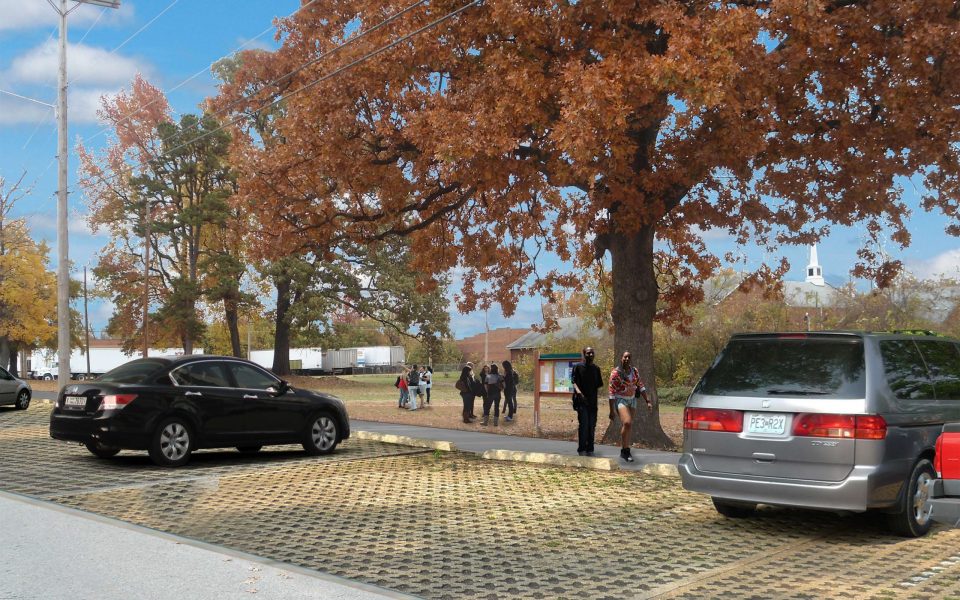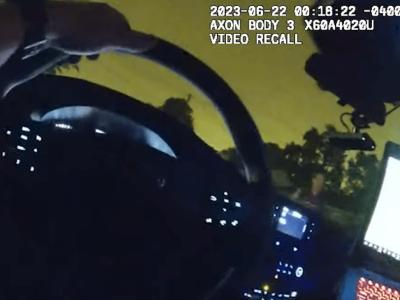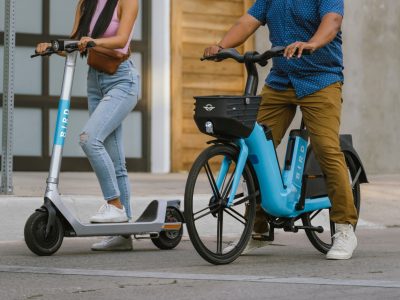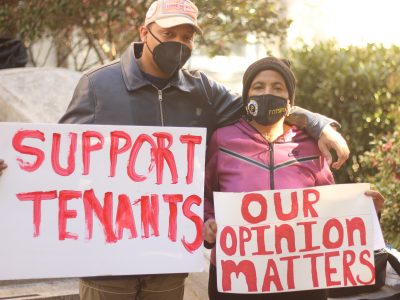A rendering depicts an imagined trailhead at BuzziSpace in the Southwest area of High Point. (image courtesy of Alta Planning & Design)
by Jordan Green
A study suggests conditions are right for a greenway through the Southwest area of High Point.
A 6-mile greenway network through the Southwest area of High Point would cost an estimated $4.1 million, according to a new draft study developed by a Durham consultant.
“While constraints are considerations for any greenway project, those that exist along the Southwest High Point Greenway corridor are not significant barriers preventing project development,” the study by Alta Planning & Design concluded. “Greenway opportunities far outweigh the challenges for this particular corridor…. The end result should be a trail that optimizes investment, connections, equity and environment.”
Dorothy Darr, the executive director of the Southwest Renewal Foundation and the project’s most ardent proponent, said the first part of the greenway to undergo construction would be Phase 1, from the Amtrak station near the center of the city to Harvell Park, with an estimate price-tag of $1.4 million. Darr said she would like to get the project added to a future city parks and recreation bond, although she said City Manager Greg Demko told her he doesn’t expect one to be on the ballot for the election this year. Darr added that she plans to research private funding in the meantime.

The study completed by Alta Planning & Design was funded by a $38,500 community development grant from the city of High Point.
From its terminus at the Amtrak station, Phase 1 runs past the Pit and then follows the defunct Thomasville-Denton railroad corridor and passes BuzziSpace, a high-end Belgian furniture manufacturer in the old Pickett Cotton Mill.
Darr is involved in an effort to establish a business incubator, which involves the purchase of the NC Shakespeare Festival facility at the corner of West Green Drive and West Ward Drive. The transaction is currently stalled as the festival undergoes dissolution. If the deal goes through, as Darr hopes, Phase 1 would extend from Harvell Park to the proposed business incubator, to be named Spirit Center.
A meeting for the greenway’s stakeholders is planned for sometime in May.
Darr said investment in the greenway would provide a significant return in both economic development and public health, citing the Downtown Greenway in Greensboro, which has spurred robust growth in apartments, a grocery store, a brewpub and other small businesses even though it’s only partially completed.
“We could be the city of parks and greenways,” Darr said. “We don’t have any major streets that come through High Point like Wendover Avenue in Greensboro or Highway 52 in Winston-Salem, so we have a lot of open space in the city. We’re trying to make the connection between access to exercise and public health. It not only improves business and creates jobs, but it also improves public health. A lot of people don’t drive in the area, so they can’t drive to a gym. They have to walk for exercise.”
As a deindustrialized area adjacent to the gleaming furniture showrooms in High Point’s central business district, the Southwest is home to some of the city’s poorest residents, with a median household income of $16,705, compared with $43,083 in the city as a whole. The population of the Southwest is also more diverse, with 23 percent of residents identifying as Latino, 44.8 percent as black, 38.7 percent as white and 10.1 percent as some other race. And the population of the Southwest is younger than the city as a whole. Crucially, the population of the Southwest is more likely to carpool, take public transportation or ride a bicycle to get to work.
“These demographics point to a need for improved and expanded employment opportunities, affordable transportation options, a walkable and bike-able environment that provides access to key destinations and amenities, and a vibrant community atmosphere that can help to retain High Point’s young and diverse population,” the Alta Planning & Design study recommends.
The economically distressed conditions of the Southwest area are not unique compared to other communities that have used greenways to promote revitalization, said Britt Storck, an associate with Alta Planning & Design, citing the American Tobacco Trail in Durham in particular.
“I think that pretty much urban trails traverse different economic levels of income and housing areas, and what my answer is to folks that feel intimidated or feel overwhelmed about walking through these areas is that the more people who use the trail, the safer they are,” Storck said. “The more these areas that are underdeveloped get noticed, the more the need for revitalization and redevelopment rises up. A greenway can expose people to areas that normally they wouldn’t be exposed to.”
The proposed greenway played a significant role in BuzziSpace’s decision to locate in the Southwest area. Company CEO Tom Van Dessel highlighted the project during the opening of BuzziSpace in December, which drew Gov. Pat McCrory and other elected officials. Van Dessel compared the furniture company’s vision for the community with that of the proposed greenway.
Terry Seitz, a furniture manufacturer who purchased a 1929-vintage brick warehouse in 2012 that was previously owned by Myrtle Desk Co., said any improvements to the area are welcome.
His new building, about a block away from Phase 1 of the proposed greenway, is a 1-minute drive from the showroom space he leases at 220 S. Elm St. in the heart of the central business district. Seitz employs about five people year round to assemble furniture imported from India, Thailand, Indonesia, Malaysia, Italy and Romania. Around the time of the twice-annual furniture market, he said he doubles the number of people assembling new furniture samples, and hires about 20 people to work as baristas, receptionists, sales representatives and caterers, along with a band to provide entertainment to buyers.
“That area’s just too close to downtown not to have great potential,” Seitz said. “Obviously, at best it’s a transitional neighborhood. Anything the city does to improve it is only going to help.”
While not minimizing the challenges of doing business in an area affected by poverty, Seitz took a positive attitude. He said he had to call the police when some locals tried to crash one of his parties during the last market. And at first he had a problem with people breaking out his windows. Then he installed security cameras, and the police showed the footage to the perpetrators, warning that the next time the property owner would press charges. The problem stopped almost immediately.
Seitz said the Southwest area of High Point reminds him of what the South Beach neighborhood in Miami was like three decades ago.
“When I first went to South Beach in Miami — I was down there in the ’80s — it was derelict,” he said. “Now, South Beach has the highest-value real estate in Florida. Back then you could buy these old art deco buildings for nothing. It looked like East Germany before reunification.
“As a believer in High Point, we need something besides the market,” Seitz added. “I want High Point to be vibrant.”
Join the First Amendment Society, a membership that goes directly to funding TCB‘s newsroom.
We believe that reporting can save the world.
The TCB First Amendment Society recognizes the vital role of a free, unfettered press with a bundling of local experiences designed to build community, and unique engagements with our newsroom that will help you understand, and shape, local journalism’s critical role in uplifting the people in our cities.
All revenue goes directly into the newsroom as reporters’ salaries and freelance commissions.







Professinal grant seeker/goat wrangler seeks money for a project that the city simply doesn’t have.
High Cost Point needs to pay a few bills and catch up on some long overdue maintenance before spending more on peripherals.
Posted April 1, hmm… Too bad, this sounds really cool.